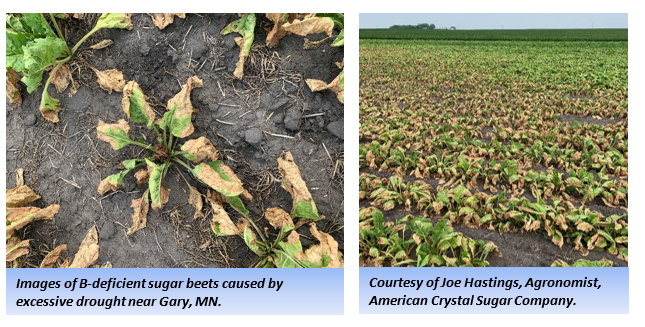Boron/Calcium Deficiency in Drought-Stressed Sugar Beets
This page was adapted from the article, "Boron/Calcium Deficiency in Drought-Stressed Sugar Beets," which appeared in Crop & Pest Report on July 29, 2021.
Boron and calcium are unique as plant nutrients, because their transport through the plant is nearly exclusively through the xylem flow. This is the flow of water through the plant from roots through leaves and out the stomates. Soils in North Dakota and the Valley-part of Minnesota have ample supplies of calcium (Ca) and boron (B) in their soils as a natural part of their organic matter and mineral base. However, when it is continuously humid/rainy in the growing season, or the crops are under severe drought, the movement of water through the xylem flow in crops stops. When this happens, a physiological deficiency of B and/or Ca may result. Below are images from a sugar beet field near Gary, MN. The diagnostic symptom for B is a dead growing point (note the brown center of the single beet image). If the center is ‘sticky’ to touch, it may also be a Ca deficiency, since this deficiency interferes with cell membrane/wall development, resulting in cells that ‘ooze’ to some degree. Also note the drooped leaves in the beets. The leaves in this field droop early in the day when it is hot. Application of B or Ca fertilizers is not the answer for these beets. Rainfall will be important for the condition not to worsen and spread to other parts of the field.

Dave Franzen
Extension Soil Specialist
701-799-2565
